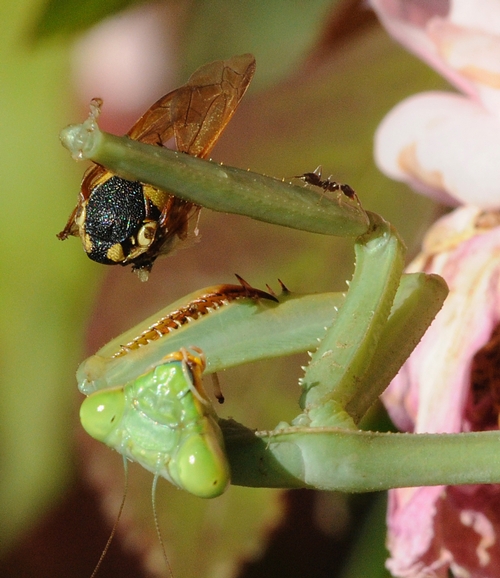- Author: Kathy Keatley Garvey
When it ought to be raining, it's raining pink.
They say you can't fool Mother Nature or outsmart Father Time but that's not the case in the UC Davis Arboretum. A red Japanese apricot, Prunus mume "Matsubara red" glows with absolute radiance in the Storer Garden. It's a early bloomer, but this year it's really early due to the springlike temperatures.
We first noticed it blooming Jan. 5. It's still blooming, and honey bees--probably from the Harry H. Laidlaw Jr. Honey Bee Research Facility on Bee Biology Road--are all over it.
The flowering apricot bears the name "red Japanese apricot," but its origin is China and Korea. It's been cultivated in Asia for some 500 years.
If you've never been to the Storer Garden, you should go. As it says on the Arboretum website: "The Ruth Risdon Storer Garden is a Valley-wise garden, featuring flowering perennials and small shrubs that are especially well suited to Central Valley gardens, including many Arboretum All-Stars, our recommended plants for Valley-wise gardens. It is designed for year-round color with low water use and low maintenance, and features a demonstration planting of roses and companion plants. Educational exhibits highlight the principles of sustainable gardening. The garden is named for Dr. Ruth Storer, Yolo County’s first pediatrician and an avid gardener."
For most of January, it's been raining pink in the Storer Garden. Now we need the wet stuff.




- Author: Kathy Keatley Garvey
Ah, what an intoxicating scent!
If you've ever been around the winter daphne, Daphne odora, cultivar "Aureomarginata," you know that its aroma precedes it.
You'll ask "What's that fragrance?" before you even see the showy pink-and-white blossoms and its green leaves edged in gold.
The winter daphne, an evergreen, is now blooming in the Ruth Risdon Storer Garden on Garrod Drive, UC Davis Arboretum.
The Storer Garden is aptly named. Ruth Storer, Yolo County’s first pediatrician, loved gardening.
We think she would have liked the honey bee hovering today in the dappled shadows of the daphne. "Table for one, please!"

- Author: Kathy Keatley Garvey
It was not a good day to "stop and smell the roses."
A vespid wasp apparently lingered too long on a rose--perhaps dropping by for a sip of nectar or seeking unsuspecting prey.
What it found was another predator, a praying mantis looking for breakfast.
The scenario unfolded last week in the Storer Garden at the University of California, Davis.
The mantid grasped the wasp in its spiked forelegs and methodically began to consume it.
It bit into the head first, thorax next, and then snatched a wing.
All that was left: a wing and a prayer.



- Author: Kathy Keatley Garvey
There's nothing like a steaming hot cup of coffee to jump-start the day.
If there's anything better than one cup, it's TWO cups.
Well, honey bees like a little caffeine, too.
And nicotine.
Scientists at the University of Haifa, Israel, found that bees prefer nectar with a small concentration of caffeine and nicotine over nectar without those substances. The bees like the amount naturally found in nature and not at the higher, more toxic levels.
A news release posted on EurekaAlert noted that the bees "clearly" favored the blossoms that gave them a little buzz.
What's caffeine and nicotine doing in flowers, you ask? Did someone pour coffee or stub their cigarette in the blossoms? No. Some plant species naturally have a little caffeine or nicotine in their floral nectar.
"Nicotine is found naturally in floral nectar at a concentration of up to 2.5 milligrams per liter, primarily in various types of the tobacco tree (Nicotiana glauca)," wrote communications specialist Rachel Feldman of the University of Haita in her news release. "Caffeine is found at concentration levels of 11-17.5 milligrams per liter, mostly in citrus flowers. In the nectar of grapefruit flowers, however, caffeine is present in much higher concentrations, reaching 94.2 milligrams per liter."
What the researchers did was offer "clean" nectar (comprised of just sugars) and artificial nectar (comprised of various natural sugar levels, coupled with various levels of caffeine and nicotine).
The bees honed in on the spiked nectar.
It's important to point out, however, that the study proved a preference, not an addiction.
And yes, the next step is to study whether the bees can become addicted to the substances.
Honey, would you like a little sugar in your coffee, or a little coffee in your sugar?


- Author: Kathy Keatley Garvey
If you stuff your turkey with sage, chances are it's Salvia officinalis.
Not the turkey, the sage.
And if you visit the Storer Garden at the UC Davis Arboretum, you'll see bumble bees stuffing themselves with nectar from the purple flowers of Salvia officinalis, cultivar Berggarten, also known as Berggarten sage.
Scores of Bombus californicus nectared the flowers last weekend, seemingly proving that this is indeed a culinary sage favored by people AND bumble bees.
Salvia officinalis (salvia is Latin for "to heal") shows up in both medicinal and culinary history. In fact, Wikipedia says our ancestors used it to ward off evil and snakebites, to increase women's fertility, "and more."
The "and more" means just that. Think of every ailment known to humankind. Now fast forward to modern times. Some researchers are using it to treat mild-to-moderate Alzheimer's disease and depression.
On the culinary side, Julia Child favored it as a flavorful herb.
Bombus californicus probably knows something that Julia Child did.





